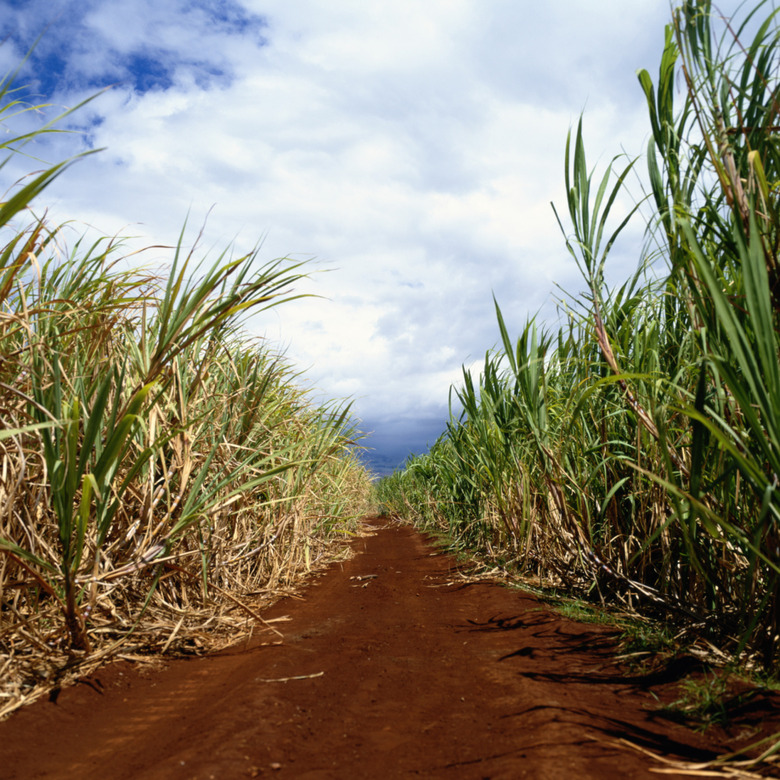Fun Facts On Sugar Cane
Sugar cane (Graminae, Poaceae Saccharum officinarum L.) is a bamboo-like plant grown as a perennial in U.S. Department of Agriculture plant hardiness zones 9 to 11. Unable to withstand cold temperatures or frost, the plants require 365 days of frost-free weather to grow. Sugar cane is not only the source of the white sugar that you put in your coffee, on your cereal or in your baked goods, but of other well-known byproducts as well.
Step 1
Sugar cane plants look a lot like grass, corn and several other grain-producing plants, because they are all members of the same family classified as monocots. Among other types of classifications, plants are grouped according to how many embryonic leaves they produce during germination. Dicots, such as most flowers and many vegetables, produce two false leaves, called cotyledons, that contain all the food the new plant will need until it becomes established and starts producing real leaves on stems along a main stalk. Monocots, as all members of the grass plant family are classified, produce a single embryonic leaf at germination, and its real leaves grow from the base rather than from side stems. A close inspection of a sugar cane stalk and a single grass plant reveals their many similarities.
Sugar Sweet
Step 1
In addition to the ubiquitous granulated white sugar, sugar cane is the source of many other products and byproducts associated with its processing. The thick dark brown liquid made from the boiled juice of sugar cane extracted during the refinement process is called molasses. At one time, molasses was one of the few readily available sweeteners that the early colonists could afford. While molasses is no longer the popular sweetening agent it once was, it is still used extensively in the commercial production of familiar foods such as baked beans and in the home kitchen for baking. Molasses is made by pressing all the juice out of the sugar cane and boiling it to reduce it to a thick liquid. Blackstrap molasses is the most concentrated form and is actually good for you, as it contains significant amounts of important nutrients such as manganese, iron and potassium.
Step 2
- Sugar cane plants look a lot like grass, corn and several other grain-producing plants, because they are all members of the same family classified as monocots.
- Dicots, such as most flowers and many vegetables, produce two false leaves, called cotyledons, that contain all the food the new plant will need until it becomes established and starts producing real leaves on stems along a main stalk.
Family Tree
Step 1
Other members of the grass family that the sugar cane plant is related to include corn (Zea mays), wheat (Triticum) and rice (Oryza). Like their cousins, sugar cane plants produce seed stalks, but unlike corn and other grasses, its seeds are not used to plant new crops. Because sugar cane seeds are not genetically identical, new canes are started from stalk cuttings taken from existing plants. Cuttings are made between two nodes along the stalk and placed horizontally in the soil. New roots develop at the sites of the nodes where buds are located beneath the leaf sheath. In the United States, sugar cane is grown in Florida, Louisiana and Hawaii.
Step 2
Growing Sugar Cane
Step 1
According to the University of Florida, "an average sugar cane stalk weighs about 3 pounds and is roughly 85 percent liquid." The 2.6 pounds of juice the cane stalk contains translates to about 1/3 of a pound of sugar. If you live in USDA zones 9 to 11, which encompass the Gulf Coast states of Florida and west to Texas and Hawaii, you can grow sugar cane, though probably not on a scale to make sugar production practical. You can, however, grow it for its ornamental value, for chewing canes or to make syrup. Called backyard sugarcane, it is grown on small lots of less than 1 to 2 acres. While sugar cane production has always been centralized in the southern parts of the United States, breeders are in the process of developing hybrid varieties that could be grown as far north as USDA zone 7.
Step 2
- Other members of the grass family that the sugar cane plant is related to include corn (Zea mays), wheat (Triticum) and rice (Oryza).
- Like their cousins, sugar cane plants produce seed stalks, but unlike corn and other grasses, its seeds are not used to plant new crops.
